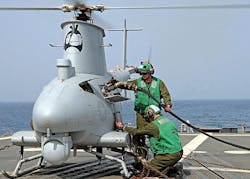Arete moves forward on multispectral UAV sensor payloads to find mines on invasion beaches
Officials of the U.S. Naval Surface Warfare Center Panama City Division in Panama City, Fla., announced an $8.5 million order to Arete last Thursday to build AN/DVS-1 Coastal Battlefield Reconnaissance and Analysis (COBRA) block 1 subassemblies to support the Littoral Combat Ship (LCS mine-countermeasures mission.
Carried on the Navy Northrop Grumman MQ-8B Fire Scout unmanned helicopter, the sensor system has limited detection capability in the surf zone. The COBRA system enables operators and personnel to remain at safe distances from mines and other obstacles. COBRA will deploy from the littoral combat ship and is an integral part of the ship's mine countermeasures mission package.
This order exercises options for Arete engineers to integrate the COBRA subassemblies and handle post-delivery technical support.
Related: Quantum Imaging to provide infrared electro-optics for multispectral targeting systems
COBRA uses multispectral sensors to conduct unmanned aerial tactical reconnaissance to detect and localize mine fields and obstacles in the surf zone and beach zone prior to amphibious assault.
The AN/DVS-1 COBRA passive multispectral sensor system is for daytime surface-laid mine line and obstacle detection in the beach zone, and has off-board processing, Arete experts say.
The COBRA payload includes stabilized step stare digital gimbal, high-resolution multispectral imaging digital camera with spinning six-color filter wheel, a processing unit, and a solid-state data storage unit.
The gimbal is about 19 inches long and 11 inches in diameter, and collects six different color-band images across a large area using a step-stare pattern. At the mission, personnel load its data storage unit into a post mission analysis station.
Related: Multispectral sensor fusion embedded computing for unmanned aircraft introduced by Headwall
The COBRA Block I system has two airborne payloads, the post mission analysis station, and the tactical control system segment for the UAV ground control station to plan the flight tracks for the COBRA mission, monitor the mission, and reprogram the flight path if necessary.
COBRA began as a U.S. Marine Corps advanced technology program in the 1990s. The system uses incremental development, with three initial blocks of development planned with each introducing new or enhanced capabilities. COBRA Blocks II and III are in concept refinement and technology development.
On this order Arete Associates will do the work in Tucson, Ariz., and should be finished by December 2019. For more information contact Arete Associates online at http://arete.com, or the Naval Surface Warfare Center Panama City Division at www.navsea.navy.mil/Home/Warfare-Centers/NSWC-Panama-City.
Learn more: search the Aerospace & Defense Buyer's Guide for companies, new products, press releases, and videos

